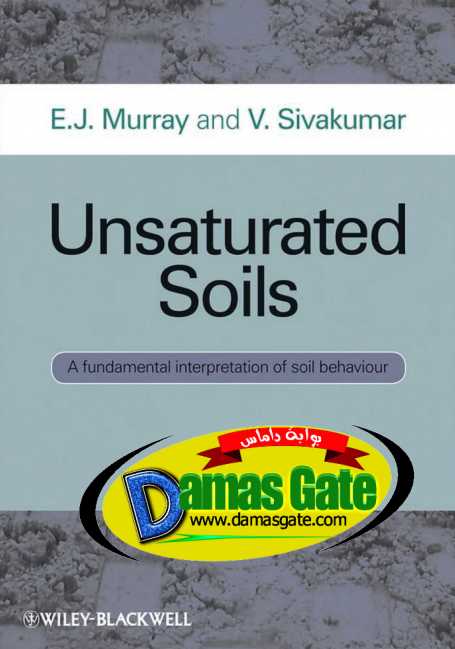Unsaturated Soils - A Fundamental interpretation of Soil Behavior

Preface
The book examines the mechanical properties of unsaturated soils. The aim is to provide
students and researchers in geotechnical engineering with a framework for understanding
soil behaviour at a fundamental level and a model for interpreting experimental data, as
well as providing practitioners with a deeper appreciation of the important characteristics
of unsaturated soils. A notable theme of the book is the interpretation of experimental
strength and compression data from stress path tests in the triaxial cell.
The three phases making up an unsaturated soil are the soil particles, water and air;
the physical and chemical properties of which vary widely. The behaviour of soils is influenced
by many factors but must be compliant with the general laws of thermodynamics
that provide broad principles to which material behaviour must adhere. The theoretical
analyses are based on sound thermodynamic principles and provide a rigorous methodology,
justified by comparison with test data, to predict and investigate the mechanical
behaviour of unsaturated soils. We have endeavoured to keep the theoretical part of the
book interesting but thorough, and have drawn on analogous behaviour in physics and
chemistry to explain important phenomena.
Chapter 1 provides a basic introduction to soil variables, the phases, the phase interactions
and the relevance of soil structure to subsequent discussions. Particular reference
is made to mercury intrusion porosimetry (MIP) testing in describing the aggregated,
bi-modal structure of unsaturated soils.
An up-to-date review of laboratory testing techniques is presented in Chapters 2 and 3,
including suction measurement and control techniques in laboratory triaxial cell testing.
The basis of the testing is important if the ideas developed from thermodynamics are to
be properly applied.
Chapter 4 introduces the stress state variables, critical state and theoretical models
in unsaturated soils. This review of current ideas provides a background to subsequent
analyses, which differ principally in the description of unsaturated soils as controlled by
a dual stress regime with the relative volumes of the phases playing an essential role in
defining the volumes through which the stresses act.
Chapters 5 and 6 dive into a detailed description of thermodynamic principles as applied
to multiphase materials under equilibrium conditions. In particular, the significance of
the thermodynamic potentials, including enthalpy, is described. It is shown that it is
possible to deal with anisotropic stress conditions as the thermodynamic potentials are
extensive variables. The significance of the minimisation of the thermodynamic potentials
at equilibrium and the meanings of equilibrium and meta-stable equilibrium are outlined.
Download
*

Preface
The book examines the mechanical properties of unsaturated soils. The aim is to provide
students and researchers in geotechnical engineering with a framework for understanding
soil behaviour at a fundamental level and a model for interpreting experimental data, as
well as providing practitioners with a deeper appreciation of the important characteristics
of unsaturated soils. A notable theme of the book is the interpretation of experimental
strength and compression data from stress path tests in the triaxial cell.
The three phases making up an unsaturated soil are the soil particles, water and air;
the physical and chemical properties of which vary widely. The behaviour of soils is influenced
by many factors but must be compliant with the general laws of thermodynamics
that provide broad principles to which material behaviour must adhere. The theoretical
analyses are based on sound thermodynamic principles and provide a rigorous methodology,
justified by comparison with test data, to predict and investigate the mechanical
behaviour of unsaturated soils. We have endeavoured to keep the theoretical part of the
book interesting but thorough, and have drawn on analogous behaviour in physics and
chemistry to explain important phenomena.
Chapter 1 provides a basic introduction to soil variables, the phases, the phase interactions
and the relevance of soil structure to subsequent discussions. Particular reference
is made to mercury intrusion porosimetry (MIP) testing in describing the aggregated,
bi-modal structure of unsaturated soils.
An up-to-date review of laboratory testing techniques is presented in Chapters 2 and 3,
including suction measurement and control techniques in laboratory triaxial cell testing.
The basis of the testing is important if the ideas developed from thermodynamics are to
be properly applied.
Chapter 4 introduces the stress state variables, critical state and theoretical models
in unsaturated soils. This review of current ideas provides a background to subsequent
analyses, which differ principally in the description of unsaturated soils as controlled by
a dual stress regime with the relative volumes of the phases playing an essential role in
defining the volumes through which the stresses act.
Chapters 5 and 6 dive into a detailed description of thermodynamic principles as applied
to multiphase materials under equilibrium conditions. In particular, the significance of
the thermodynamic potentials, including enthalpy, is described. It is shown that it is
possible to deal with anisotropic stress conditions as the thermodynamic potentials are
extensive variables. The significance of the minimisation of the thermodynamic potentials
at equilibrium and the meanings of equilibrium and meta-stable equilibrium are outlined.
Download
*